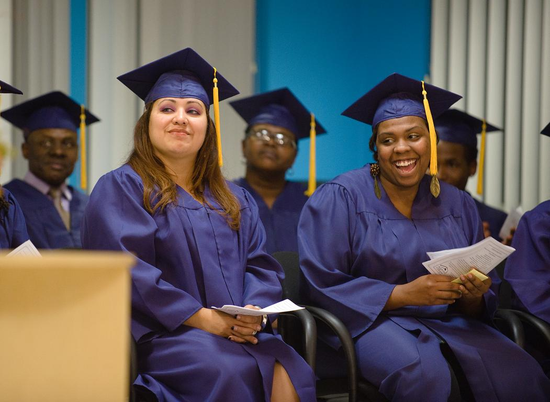Whitney is an unassuming, quiet but friendly young woman who, like her peers, has earplugs in her ears more often than not. But don’t be fooled by her appearances. She is a very determined young woman. She is not yet 19 years old, but she is already a mother, working hard to move from transitional housing and dependence on TANF assistance to employment that will allow her to provide for herself and her child. She earned her GED last September, but she knows to get a job that pays enough to sustain her and her child, she needs college and/or a postsecondary credential. That’s why she’s enrolled in bridge-to-college classes at Academy of Hope.
When Whitney first enrolled at Academy of Hope, she was
part of a DOES-funded GED program for youth that included a transportation
stipend. For Whitney, this meant that
she could take the Metro from her transitional housing in South East DC to
Edgewood Terrace near the Rhode Island Avenue Metro, where Academy of Hope’s
Strive for Success classes were held. It
took about 45 minutes and cost between $2.05 and $4.10 each way. The cost, of course, depended on
the time of day she traveled (peak times to get to school, non-peak to get back
home) and whether she took a bus to school from the Rhode Island Metro or chose
to take the 10-minute walk. When funding
for transportation stipends ended, Whitney’s commute to school became both a
financial burden and a larger time commitment.
In order to save money, Whitney no longer rides the Metro. She takes a
couple of buses and spends more than an hour traveling each way. The trip costs $1.60 each way, which amounts
to $3.20 a day, $12.80 for the four days of class a week and $16.00 a week if
she comes in for tutoring on Friday. The
extra 15-20 minutes commuting each way adds more than a couple of hours a week.
 To those of us with salaried jobs, whether middle wages
or high end, $16 a week doesn’t sound like all that much money, but put it in context. $16 a week is $48 a month. Whitney’s total
income for the month is $336, which she receives through TANF. A third of that goes to rent at the
transitional house where she is living.
That leaves $216 for everything else, including food, diapers for the
baby, clothing, personal hygiene, transportation, etc. for the month. Whitney feels lucky because she’s healthy and
her baby’s healthy, so she doesn’t have to decide between medicine and
transportation. She is determined to get the education she needs for a better
life for herself and her daughter.
To those of us with salaried jobs, whether middle wages
or high end, $16 a week doesn’t sound like all that much money, but put it in context. $16 a week is $48 a month. Whitney’s total
income for the month is $336, which she receives through TANF. A third of that goes to rent at the
transitional house where she is living.
That leaves $216 for everything else, including food, diapers for the
baby, clothing, personal hygiene, transportation, etc. for the month. Whitney feels lucky because she’s healthy and
her baby’s healthy, so she doesn’t have to decide between medicine and
transportation. She is determined to get the education she needs for a better
life for herself and her daughter.
There are other students who don’t have even the minimal
income of TANF or supportive housing who struggle to meet their basic needs,
who live even farther away from school or have more family members dependent on
them. These students end up dropping out of school because they simply cannot win the
battle of showing up to class. Providing assistance, such as a transportation stipend or extending Kids Ride Free, will break down a major barrier that prevents non-traditional students, such as Whitney, from breaking the cycle of poverty. Whitney is making the commitment to show up to class and better her situation. Now it's the city's turn to ease Whitney's ride to school so she may continue changing her life not only for herself, but for child.
For more on youth issues in DC you can FOLLOW us on Twitter, LIKE us on Facebook, SUBSCRIBE to this blog and VISIT us at www.dc-aya.org.



No comments:
Post a Comment